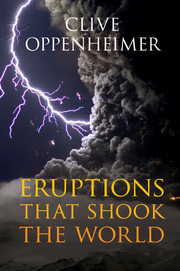Book contents
- Frontmatter
- Contents
- Preface
- Acknowledgements
- 1 Fire and brimstone: how volcanoes work
- 2 Eruption styles, hazards and ecosystem impacts
- 3 Volcanoes and global climate change
- 4 Forensic volcanology
- 5 Relics, myths and chronicles
- 6 Killer plumes
- 7 Human origins
- 8 The ash giant/sulphur dwarf
- 9 European volcanism in prehistory
- 10 The rise of Teotihuacán
- 11 Dark Ages: dark nature?
- 12 The haze famine
- 13 The last great subsistence crisis in the Western world
- 14 Volcanic catastrophe risk
- Appendix A Large eruptions
- Appendix B Further reading and data sources
- References
- Index
11 - Dark Ages: dark nature?
Published online by Cambridge University Press: 01 June 2011
- Frontmatter
- Contents
- Preface
- Acknowledgements
- 1 Fire and brimstone: how volcanoes work
- 2 Eruption styles, hazards and ecosystem impacts
- 3 Volcanoes and global climate change
- 4 Forensic volcanology
- 5 Relics, myths and chronicles
- 6 Killer plumes
- 7 Human origins
- 8 The ash giant/sulphur dwarf
- 9 European volcanism in prehistory
- 10 The rise of Teotihuacán
- 11 Dark Ages: dark nature?
- 12 The haze famine
- 13 The last great subsistence crisis in the Western world
- 14 Volcanic catastrophe risk
- Appendix A Large eruptions
- Appendix B Further reading and data sources
- References
- Index
Summary
It is frequently overlooked that both “climate” and “history” are blanket terms, situated on such a high level of abstraction that relationships between them cannot be investigated in a meaningful way in accordance with the rules of scientific methodology … Whether and to what extent climatic factors mattered for social vulnerability needs to be determined through empirical analyses.
C. Pfister, Climatic Change, 2010 [188]The signatures of many famous eruptions have been recognised in the ice-core records. For instance, the sulphate layers sourced from the eruptions of Mount Mazama (~5677 BCE), Vesuvius (79 CE), Huaynaputina (1600), Krakatau (1883) and Pinatubo (1991) have all been reported. But even a perfunctory review of the ice-core sulphate archives indicates that there are many more acid layers from as yet unidentified eruptions. The responsible volcanoes have thus far evaded detection. What is more, tree rings and, for the historical period, assorted documents, give testimony to a number of major explosive volcanic episodes and their associated climatic impacts. In the case of one of these mysteries, taking place around 536 CE, much has been written, including excessive claims that the consequences of a great eruption marked a turning point in history between the ‘ancient’ and ‘modern’ worlds.
In truth, it is rather difficult to substantiate some of these more startling or fanciful hypotheses – the ‘Dark Ages’ did not get their moniker without reason (though since the term is considered so tendentious by medieval historians today I promise not use it again).
- Type
- Chapter
- Information
- Eruptions that Shook the World , pp. 253 - 268Publisher: Cambridge University PressPrint publication year: 2011



